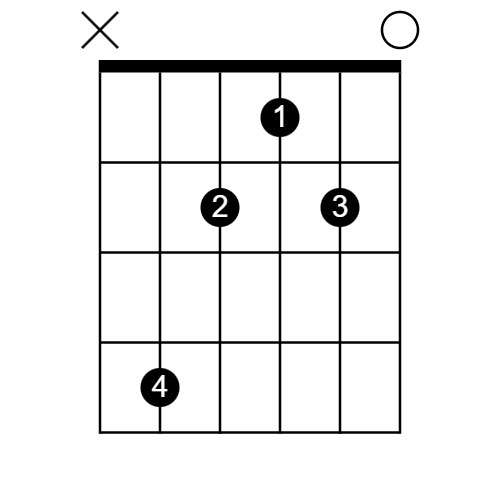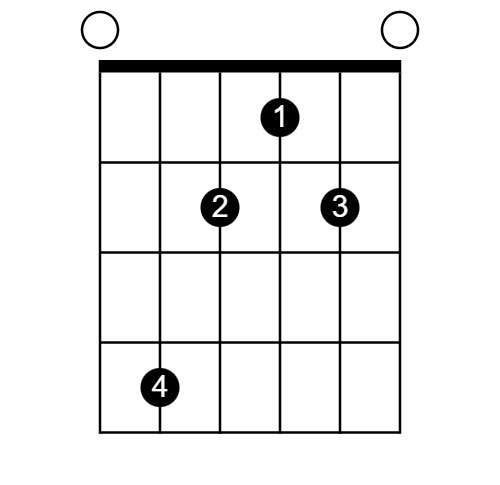The combination of 3 or more notes played together simultaneously are what constitute a guitar chord. These chords are fundamental to the world of music & foundation for building harmony across all genres of music. In this article we explore the guitar chord C#m, also known as the “C sharp minor chord“.
We’ll cover the theory behind it, as well as how to play it in a handful of ways (some much more challenging than others), but also show you an easy way to add it to your repertoire.

The Essential Role of Guitar Chords: A Spotlight on C# Minor
Chords are the backbone of music for both acoustic and electric guitar players, providing the harmonic framework that gives a piece its depth and character.
Among these, the C# minor chord stands out for its poignant, melancholic tone that adds a touch of intrigue to a musical piece. Comprising the notes C#, E, and G#, the C#m chord imbues songs across various genres with its dark and emotive quality, making it a staple in the modern musician’s repertoire.
C Sharp Minor Guitar Chord Theory
The guitar chord C#m, a staple in the musical world, is a minor triad that consists of three specific notes: the root note C#, the minor third E, and the perfect fifth G#.
This structure defines the chord’s emotional and harmonic character. The root note C# establishes the tonal center, grounding the chord and providing a reference point for the other intervals. The minor third E introduces a somber quality, infusing the chord with a sense of introspection and melancholy, which is characteristic of minor chords. The perfect fifth G# completes the triad, bringing stability and balance to the chord, and ensuring that despite its inherent tension, the chord has a resolved and consonant sound.
Understanding the interplay between these intervals is key to mastering not just the C#m chord but also the broader family of minor chords.
The root note offers a sense of stability and resolution, the minor third gives the chord its emotional depth, and the perfect fifth ensures a balanced and complete sound.
This triad forms a fundamental part of music theory and is essential for musicians looking to convey a range of emotions through their playing.
Components of the C# Minor Chord
| Interval | Note | Function |
|---|---|---|
| Root | C# | Tonal center and foundation of the chord |
| Minor Third | E | Adds a somber and introspective mood |
| Perfect Fifth | G# | Provides stability and balance |

How To Play The Guitar Chord C#m
If you didn’t know, reading a guitar chord chart involves understanding the visual representation of a fretboard.
The horizontal lines represent each fret & the vertical lines indicate all the strings.
The black dots or numbers on the chart indicate where to place your fingers on the corresponding strings and which fret to press.
The numbers typically represent which finger to use first finger being the index finger, second finger being the middle, and so on.
The O’s up top signify open strings or they’ll have an X to represent muted strings.
For more info on this topic, check out our other article on how to read guitar chord charts.
Open Position Chord Shape
So this chord shape is what is known as an open chord shape as it includes strings that are note pressed down on a fret. Usually there will be multiple open strings but the C sharp minor chord only has 1 open string.

This chord shape is a challenge but here’s how to play it:
- Place your first finger (index finger) on the first fret of the third string (G)
- Next, place your second finger (middle) on the 2nd fret of the fourth string (D)
- Then, place your third finger (ring) on the 2nd fret of the second string (B)
- Next, place your fourth finger (pinky) on the fourth fret of the fifth string (A)
- Finally, strum all of the strings including the high e string (first string) – EXCEPT the low e string
Easy Way To Play C#m
If you’re still alive with hand in tact, & looking for easier versions, try this.
This chord shape only requires three strings to be fretted, all of which are the original 3 minor intervals.

- To play it, place your index finger on the first fret of the third string (G)
- Then, place your second finger on the 2nd fret of the fourth string (D)
- Next, place your third finger on the 2nd fret of the second string (B)
- Finally, strum the top 4 strings & exclude the low E string & the A string.
Tips For Achieving Clean Sound & Proper Positioning
When playing any guitar chord like C#m, achieving a clean sound requires attention to proper hand positioning and technique. Here are a few tips to help you achieve a clear and crisp sound when playing the C#m chord:
- Apply even pressure: Ensure that your fingers press down on the strings with an even amount of pressure, allowing each note in the chord to ring out clearly without any muted or buzzing sounds.
- Avoid touching neighboring strings: Pay attention to your finger placement and ensure that each finger only touches the string it is intended to press down on.
- Arch your fingers: Aim for an arched finger position rather than flat fingers on the fretboard. This allows for clean string separation and prevents unintentional muting of other strings.
- Practice proper finger placement: Take time to focus on placing your fingers right behind the intended frets rather than in the middle of them. This will help produce a clearer tone and minimize any accidental muting.
Remember, achieving proficiency with any guitar chord takes practice, so be patient with yourself as you work on mastering the C sharp minor chord.

C Sharp Minor Guitar Chord Variations & Inversions
In order to add depth and versatility to your guitar playing, we can explore different voicings & inversions of C sharp minor. These variations provide some unique textures and open up new possibilities across the fretboard with a universal shape like a barre chord.
Barre Chord Variations
One widely used technique for playing the guitar chord C#m across various positions on the fretboard is by utilizing a barre chord.
Barre chords involve using one finger to press down multiple strings at a specific fret, essentially acting as a movable nut or capo.
The benefit of barre chords lies in their portability, allowing you to play any chord by moving the same shape up or down the neck. Learn more about barre chords here.
Movable Barre Chords & Their Benefits
Movable barre chords offer immense benefits for guitarists who want to quickly expand their musical vocabulary.
With a versatile shape like this, you can easily transpose any major or minor chord across different keys without having to learn new fingerings each time.
This flexibility allows for seamless integration into different musical contexts. The key advantage of using barre chords is that they give you access to a wide range of possible voicings for the guitar chord C#m without needing open strings in your playing position.
C#m Barre Chord Diagram

C#m Open Chord Inversion
A chord inversion is when you change the order of the notes in a chord, so a different note becomes the lowest one. It’s like rearranging the stack of notes while keeping the same “ingredients” to make the chord sound different and sometimes smoother.
First Inversion – Guitar Chord C#m

Second Inversion – Guitar Chord C#m

Frequently Asked Questions
What does C sharp M mean?
“C sharp M” typically refers to the chord C sharp major. In music notation, the letter “M” is often used as an abbreviation for “major.”
Therefore, “C sharp M” means the C sharp major chord, which consists of the notes C#, E#, and G#.
The “sharp” symbol (#) indicates that the C note is raised by one half step, making it C#.
If the “M” is lower case however, then it implies a “minor chord” & the notes would instead be C#, E, G#
What notes make up C sharp minor?
The C sharp minor chord is composed of the notes C# (C sharp) as the root, E as the minor third, and G# (G sharp) as the perfect fifth.
Is C-sharp minor the same as a major?
No, C-sharp minor is not the same as C-sharp major. C-sharp minor has the notes C#, E, and G#, while C-sharp major consists of the notes C#, E#, and G#.
The difference lies in the third note: C-sharp minor has a minor third (E), and C-sharp major has a major third (E#).
Major chords will also have a more jovial & bright sound, while minor chords are darker & moody sounding. These distinctions gives each chord its unique & different sound.
